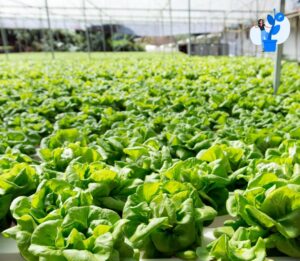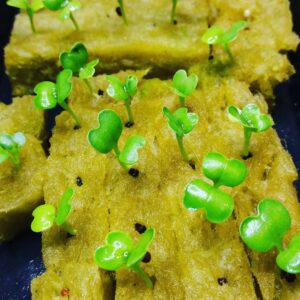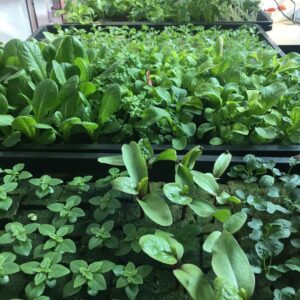How to start seeds for hydroponics? To reap the full benefits of hydroponic gardening, it’s important to start seeds correctly. Seed starting is a crucial step in any gardening, and hydroponics is no exception. Starting seeds correctly ensures that your plants will grow healthy and strong, giving you the best possible yields.
One of the biggest advantages of hydroponic gardening is that it allows you to grow plants in a smaller space with fewer resources. Because hydroponic systems deliver nutrients directly to the roots, plants grow faster and produce more yields in a shorter amount of time.
This makes hydroponics an ideal solution for people who want to grow their fresh produce at home but have limited space or resources.
When you start your seeds properly, you give your plants the best possible chance of thriving in a hydroponic system. This means ensuring that your seeds are of high quality, preparing the seedling tray correctly, using the right growing medium, and providing the correct amount of light and water.
By following the right steps to start your seeds for hydroponics, you can create a thriving garden full of healthy, nutritious plants that will provide you with fresh produce all year round.
So, let’s dive into the world of hydroponics and learn how to start seeds for this exciting and innovative method of gardening.
Why Starting Seeds Correctly Matters
Starting seeds correctly is critical to the success of your hydroponic garden. When you start your seeds off on the right foot, you give your plants the best possible chance of thriving in a hydroponic system. On the other hand, starting seeds incorrectly can lead to poor plant growth, reduced yields, and even plant death.
In hydroponics, the roots of your plants are directly exposed to the nutrient solution. If your seeds are not started correctly, they may not be able to take up the nutrients they need to grow and thrive.
For example, if your growing medium is not properly prepared, it can become compacted and prevent roots from growing properly. Or, if you use the wrong type of growing medium, it may not provide the necessary support for your plants.

Additionally, starting seeds incorrectly can lead to issues such as disease, pests, and other problems that can harm your plants. If your seeds are not planted at the right depth, they may not germinate properly or may grow weak and spindly. And if you don’t provide the right amount of light and water, your plants may become stressed and more susceptible to disease and pests.
By taking the time to start your seeds correctly, you set your hydroponic garden up for success. This means choosing high-quality seeds, properly preparing your seedling tray, selecting the right growing medium, and providing the appropriate amount of light and water.
With a little bit of effort and attention to detail, you can create a thriving hydroponic garden full of healthy, vibrant plants that will provide you with fresh produce year-round.
Materials Needed for Starting Seeds in Hydroponics
To start seeds in a hydroponic system, you’ll need a few essential pieces of equipment. Here’s a list of the basic items you’ll need:
- Seedling tray: This is where you’ll plant your seeds. Look for a tray that is shallow and has drainage holes to prevent water from pooling. There are many options available, such as plastic or reusable trays.
- Growing medium: This is the material in which your seeds will germinate and grow. Popular growing media for hydroponics include rock wool cubes, peat moss plugs, and coconut coir. Choose a medium that is appropriate for the size and type of plants you’re growing.
- Seeds: Choose high-quality seeds that are well-suited for hydroponic growing. You can purchase seeds from a variety of sources, including online retailers and garden centers.
- Grow lights: Since hydroponic systems don’t rely on natural sunlight, you’ll need to provide your plants with artificial light. LED grow lights are a popular choice for hydroponic gardening, as they are energy-efficient and provide the right spectrum of light for plant growth.
- Nutrient solution: This is the mixture of water and nutrients that your plants will feed on. There are many commercially available nutrient solutions specifically designed for hydroponics, or you can make your own using a recipe tailored to your plant’s needs.
When it comes to choosing specific products or brands, there are many options available. Some popular brands for seedling trays include Hydrofarm and Bootstrap Farmer. For growing media, Grodan rockwool cubes and Rapid Rooter peat moss plugs are popular choices. For LED grow lights, consider brands such as Viparspectra or Mars Hydro.

Overall, the equipment you choose will depend on your specific needs and budget. However, by choosing high-quality products and following best practices for starting seeds in hydroponics, you can set your garden up for success.
Choosing the Right Seeds for Hydroponics
Choosing the right seeds is key to a successful hydroponic garden. When selecting seeds, there are several factors to consider to ensure they’re well-suited for hydroponic growing.
One important consideration is the plant’s size. In hydroponics, space can be limited, so selecting seeds for plants that are naturally compact can help maximize your yield. Additionally, consider the growth rate of the plant. Seeds that produce fast-growing plants can help you achieve a quicker harvest.
Lastly, make sure to choose seeds that have nutrient requirements that are appropriate for hydroponic growing. Some plants require specific nutrients or pH levels that may be different from traditional soil-based growing.
Some popular plants that are commonly grown in hydroponic systems include:
- Lettuce: Lettuce is a great choice for hydroponics because it grows quickly and is relatively compact. It also doesn’t require a lot of light, making it a good option for indoor growing.
- Herbs: Many herbs, such as basil, parsley, and cilantro, thrive in hydroponic systems. They grow quickly and can provide a continuous supply of fresh herbs.
- Tomatoes: While tomatoes require a bit more space and light than other hydroponic plants, they can be incredibly rewarding. They produce a high yield and can be grown year-round.
- Strawberries: Strawberries are another popular choice for hydroponic gardening. They produce sweet, juicy berries and can be grown vertically to save space.
When selecting seeds for your hydroponic garden, make sure to research the specific requirements of each plant to ensure it’s a good fit for your system. With the right seeds and a little bit of attention, you can enjoy a bountiful harvest from your hydroponic garden.
Preparing the Hydroponic System for Seedlings
Preparing the hydroponic system for seedlings is an important step in starting a successful hydroponic garden. Here’s how to set up your hydroponic system for seedlings:
- Fill the trays with nutrient-rich water: Start by filling your seedling trays with a nutrient-rich water solution. Make sure the water is at the appropriate temperature and pH level for your plants. If you’re using a commercial nutrient solution, follow the manufacturer’s instructions for mixing.
- Place the seedlings in the trays: Plant your seeds in the seedling plugs or growing medium of your choice, and then place them in the seedling trays. Make sure they’re evenly spaced and not overcrowded, as this can lead to poor growth.
- Provide adequate light and humidity: Seedlings require bright light and high humidity levels to grow. Make sure your grow lights are positioned at the appropriate distance from the seedlings to provide the right amount of light. You can also use a humidifier or mist the plants regularly to maintain high humidity levels.
As your seedlings mature, you’ll need to adjust the growing environment to ensure they continue to thrive. Here are some steps you can take:
- Adjust nutrient levels: As your plants grow, they’ll require different nutrient levels. Adjust the nutrient solution accordingly to ensure your plants are getting the right balance of nutrients.
- Increase light exposure: As your plants grow taller, they’ll need more light exposure. Adjust the height of your grow lights or add additional lights to ensure they’re getting the right amount of light.
- Transplant to larger containers: Once your plants outgrow their seedling trays, transplant them to larger containers with fresh growing medium and nutrient solution.
By providing your seedlings with the right environment and making adjustments as they grow, you can ensure they develop into healthy, productive plants.

Can Any Seed Be Used for Hydroponics?
While you can use many different types of seeds for hydroponics, it’s important to select seeds that are well-suited for this growing method. Some plants may not do as well in hydroponic systems as they would in soil-based gardens.
When selecting seeds for hydroponic growing, consider factors such as the plant’s size, growth rate, and nutrient requirements. Choose seeds for plants that are naturally compact and have a fast growth rate to maximize your yield. Additionally, make sure to select seeds that have nutrient requirements that are appropriate for hydroponic growing.
It’s also important to choose high-quality seeds from a reputable source. Make sure the seeds you’re using are viable and have a high germination rate, as this will increase your chances of success.
*While you can technically use any seeds for hydroponics, it’s important to choose seeds that are well-suited for this growing method and to ensure they’re high-quality and viable. By selecting the right seeds and providing your plants with the right growing environment, you can enjoy a bountiful harvest from your hydroponic garden.*
Where to buy seeds for hydroponics
There are several places where you can buy seeds for hydroponics, including:
- Online retailers: Many online retailers specialize in hydroponic gardening supplies, including seeds. These retailers often carry a wide variety of seeds that are well-suited for hydroponic growing, making it easy to find exactly what you need.
- Local hydroponic stores: If you have a hydroponic gardening store near you, it’s worth checking to see if they carry seeds. These stores often have a good selection of seeds that are specifically chosen for hydroponic growing.
- Garden centers and nurseries: While garden centers and nurseries may not have as large of a selection of seeds as hydroponic stores, they often carry seeds for common hydroponic plants like lettuce and herbs.
- Seed banks: Some seed banks specialize in high-quality seeds that are specifically chosen for hydroponic growing. These seeds are often carefully selected for their vigor, growth rate, and nutrient requirements.

No matter where you choose to buy your seeds, it’s important to make sure they’re high-quality and well-suited for hydroponic growing.
Look for fresh seeds, that have a high germination rate, and are specifically recommended for hydroponic systems. With the right seeds and growing environment, you can enjoy a successful hydroponic garden.
Steps to Start Seeds for Hydroponics
Starting seeds for hydroponics can be a great way to grow plants indoors without the need for soil. Here are the step-by-step instructions on how to start seeds for hydroponics:

- Choosing the right seeds: As discussed earlier, choose seeds that are well-suited for hydroponic growing. Select seeds that have nutrient requirements that are appropriate for hydroponic growing and are naturally compact with a fast growth rate.
- Preparing the seedling tray: Fill a seedling tray with a nutrient-rich growing medium. Popular options include rockwool cubes, peat moss plugs, or coconut coir. Make sure the growing medium is moist before planting the seeds.
- Adding the growing medium: Place one seed in each plug or cube, making sure to bury it to the appropriate depth. Use a pencil or other pointed object to make a small hole in the center of the plug or cube and drop the seed inside. Cover the seed with a small amount of the growing medium.
- Planting the seeds: Place the seedling tray under grow lights or in a sunny location. Make sure to provide the right amount of light and water to encourage the seeds to germinate. Follow the instructions on the seed packet for specific lighting and watering requirements.
- Providing the right amount of light and water: As the seedlings grow, make sure to adjust the lighting and water as needed. Seedlings need 16-18 hours of light per day, so if you are using grow lights, make sure to adjust the height to keep the light at the appropriate distance from the seedlings. Monitor the moisture level of the growing medium and make sure it stays moist but not waterlogged.
In summary, starting seeds for hydroponics is a simple process that requires choosing the right seeds, preparing the seedling tray, adding the growing medium, planting the seeds, and providing the right amount of light and water. With these steps, you can grow healthy and vibrant plants using hydroponics.
Planting the Seeds in the Hydroponic System
Once your seeds have sprouted and developed into seedlings, it’s time to transplant them into your hydroponic system. Here are the step-by-step instructions for planting seeds in a hydroponic system:
- Prepare the seedling plugs: Gently remove the seedlings from the seedling tray and carefully separate them from the growing medium. If you are using rockwool cubes or peat moss plugs, be sure to rinse them thoroughly with pH-adjusted water to remove any excess nutrients.
- Transfer the seedlings to the hydroponic system: Carefully place the seedlings into the hydroponic system, making sure to keep the roots intact and avoid damaging them. If you are using a deep-water culture system, make sure the roots are fully submerged in nutrient-rich water.
- Maintain proper temperature and humidity levels: Seedlings need the right conditions to grow successfully, so it’s important to maintain a consistent temperature and humidity level in your hydroponic system. Keep the temperature between 65-80°F (18-27°C) and the humidity level between 50-70%.
- Adjust the nutrient levels: Seedlings have different nutrient requirements than mature plants, so it’s important to adjust the nutrient levels accordingly. Follow the instructions on your nutrient solution and adjust as needed based on the growth of your seedlings.
- Monitor and adjust the pH level: Keep an eye on the pH level of your hydroponic system and adjust as needed to maintain the optimal range for your plants.
- Provide adequate lighting: Seedlings need 16-18 hours of light per day, so make sure to provide them with enough light to encourage healthy growth. Adjust the height of your grow lights to keep them at the appropriate distance from the seedlings.
By following these steps, you can successfully transplant your seedlings into your hydroponic system and encourage healthy growth. With a little care and attention, you can grow a bountiful harvest using hydroponics.

Caring for Seedlings in the Hydroponic System
Caring for your seedlings in a hydroponic system is crucial for ensuring healthy growth and a bountiful harvest. Here’s how to monitor and adjust the hydroponic system as needed:
- Monitor growth: Keep a close eye on your seedlings and monitor their growth regularly. Look for signs of healthy growth, such as new leaves and sturdy stems. If you notice any signs of distress, such as yellowing or wilting, take action immediately.
- Adjust nutrient levels: As your seedlings grow, their nutrient requirements will change. Monitor the pH level and nutrient levels in your hydroponic system and adjust as needed to ensure your plants have the right balance of nutrients.
- Adjust lighting: Seedlings need plenty of light to grow properly. Adjust the height of your grow lights to keep them at the appropriate distance from your plants. If your seedlings are stretching toward the light, it may be a sign that they need more light.
- Prevent pests and disease: Keep a close eye on your seedlings for signs of pests or disease. To prevent these problems, keep your hydroponic system clean and sanitized, and avoid introducing pests or diseases from other plants.
- Maintain the right temperature and humidity: Seedlings need the right conditions to grow properly. Maintain a consistent temperature and humidity level in your hydroponic system to encourage healthy growth.
By monitoring your seedlings closely and adjusting your hydroponic system as needed, you can prevent common problems and encourage healthy growth. With a little care and attention, you’ll be rewarded with a bountiful harvest of fresh, healthy plants.
Conclusion
Starting seeds for hydroponics is a simple and rewarding way to grow healthy, fresh plants at home. By following the steps outlined in this article, you can set up your hydroponic system and start growing your plants in no time.
We’ve covered the benefits of hydroponic gardening, the importance of starting seeds correctly, the materials needed for starting seeds in a hydroponic system, how to choose the right seeds for hydroponics, and the steps for preparing the hydroponic system and planting the seeds.
Remember to care for your seedlings by monitoring their growth, adjusting nutrient levels and lighting, preventing pests and disease, and maintaining the right temperature and humidity.
If you want to learn more about hydroponic gardening, there are plenty of additional resources available online. Check out hydroponic gardening blogs, forums, and YouTube channels for tips and advice from experienced growers.
With a little patience and attention, you’ll soon be enjoying a bountiful harvest of fresh, healthy plants grown in your hydroponic system.
